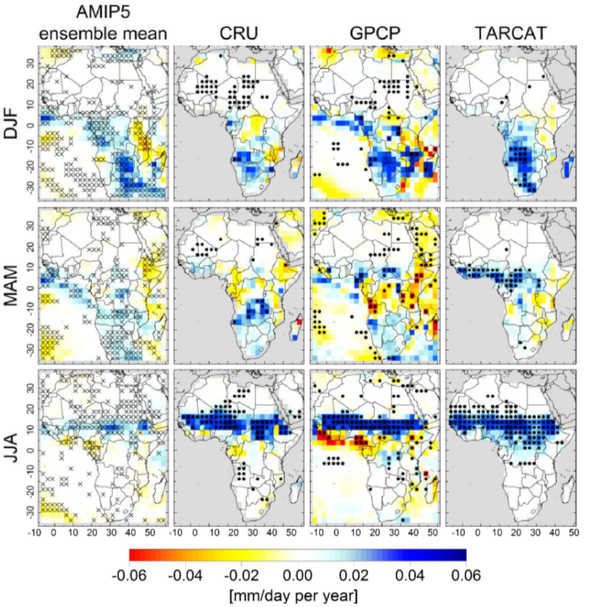Changing rainfall can have profound societal consequences across Africa where it plays a crucial role in sustaining livelihoods and economic development. Predicting how rainfall patterns will alter as the planet warms in response to human-caused greenhouse gas emissions is therefore of great importance; for this both observations and simulations are vital. A new analysis of observed and simulated changes in rainfall over Africa has been published by the University of Reading TAMSAT group: the main results along with discussion of some other important studies are summarised below:
Figure 1: Rainfall trends (in mm/day per year) for 3 seasons over the period 1983-2008 in (1) atmosphere climate models (AMIP) that are fed with the observed sea surface temperature and sea ice, (2) the Climate Research Unit (CRU) rain gauge dataset, (3) the Global Precipitation Climatology project combined gauge and satellite dataset and the (4) TARCAT satellite-based dataset. See Maidment et al. (2015) for more details.
In our analysis, we excluded datasets which contained unrealistic jumps in the time series (attributable to changing coverage of rain gauge measurements or other factors). For the remaining datasets, the simulations broadly capture the observed changes in rainfall in the regions outlined above indicating that they can be explained by changes in sea surface temperature, the radiative forcings or a combination. They also add confidence in the robust nature of the observed rainfall trends. Projecting future climate change requires fully coupled climate simulations in which the ocean temperature and circulation are free to vary (unlike in the AMIP experiments we used to assess current changes). It is important that the seasonal characteristics of rainfall patterns simulated by these fully coupled models are realistic. This requires improved understanding of the physical processes that determine the climate in key regions such as West Africa and the Horn of Africa which involves combining satellite and conventional observations with detailed modelling as for example planned under current missions such as the DACCIWA project.
References
- Dong and Sutton (2015) Dominant role of greenhouse-gas forcing in the recovery of Sahel rainfall,Nature Clim. Ch., doi: 10.1038/nclimate2664
- Evan et al. (2015) Water Vapor-Forced Greenhouse Warming over the Sahara Desert and the Recent Recovery from the Sahelian Drought, J. Climate, doi: 10.1175/JCLI-D-14-00039.1
- James et al. (2015) Process-based assessment of an ensemble of climate projections for West Africa, J. Geophys. Res., doi: 10.1002/2014JD022513
- Knippertz et al. (2015) The DACCIWA Project: DynamicsAerosolChemistryCloud Interactions in West Africa, Bull. American Meteorol. Soc., doi: 10.1175/BAMS-D-14-00108.1
- L’Heureux et al. (2013) Recent multidecadal strengthening of the Walker circulation across the tropical Pacific, Nature Clim. Ch., doi: 10.1038/nclimate1840
- Maidment et al. (2015) Recent observed and simulated changes in precipitation over Africa,Geophys. Res. Lett., doi: 10.1002/2015GL065765
- Tierney et al. (2015) Past and future rainfall in the Horn of Africa, Science Advances, doi:10.1126/sciadv.1500682
- Trenberth (2015) Has there been a hiatus? Science, 349, p. 691-692, doi:10.1126/science.aac9225
- Yang et al. (2015) The Rainfall Annual Cycle Bias over East Africa in CMIP5 Coupled Climate Models, J. Climate, doi: 10.1175/JCLI-D-15-0323.1
